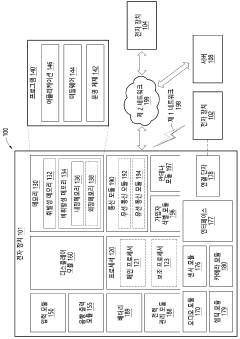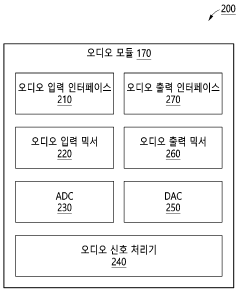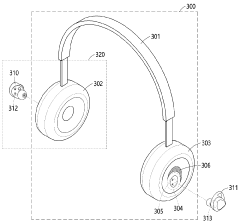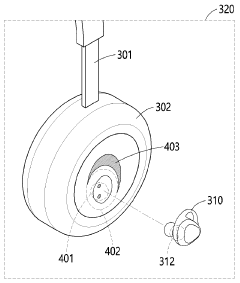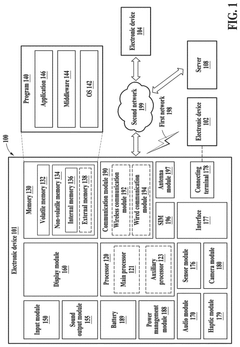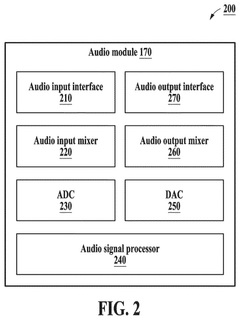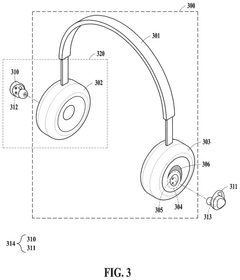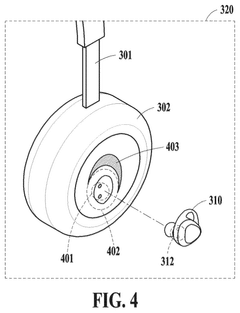LDAC: Powering the Next Generation of Audiophile Headphones
JUL 4, 20259 MIN READ
Generate Your Research Report Instantly with AI Agent
Patsnap Eureka helps you evaluate technical feasibility & market potential.
LDAC Evolution and Objectives
LDAC, developed by Sony in 2015, represents a significant leap in wireless audio technology. This codec aims to deliver high-resolution audio over Bluetooth connections, addressing the growing demand for superior sound quality in wireless devices. LDAC's evolution is closely tied to the increasing consumer appetite for high-fidelity audio experiences, particularly in the audiophile headphone market.
The primary objective of LDAC technology is to overcome the limitations of traditional Bluetooth audio codecs, which often compromise sound quality due to bandwidth constraints. LDAC achieves this by employing advanced encoding techniques that allow for transmission of audio data at up to 990 kbps, significantly higher than standard Bluetooth codecs like SBC or AAC.
Since its inception, LDAC has undergone several iterations to improve its performance and compatibility. Initially exclusive to Sony devices, the technology was later made available to other manufacturers through the Android Open Source Project (AOSP) in 2017. This move greatly expanded LDAC's reach and adoption across the audio industry.
The evolution of LDAC has been driven by the need to balance three key factors: audio quality, power consumption, and connection stability. Each iteration has sought to optimize these aspects, with recent developments focusing on reducing latency and improving energy efficiency without compromising sound quality.
Looking ahead, the objectives for LDAC technology in powering the next generation of audiophile headphones are multifaceted. One primary goal is to further increase the data transmission rate, potentially pushing beyond the current 990 kbps limit to accommodate even higher resolution audio formats. Another objective is to improve the codec's adaptability to varying network conditions, ensuring consistent high-quality performance across different usage scenarios.
Additionally, there is a focus on enhancing LDAC's integration with emerging audio technologies such as 3D audio and personalized sound profiles. This integration aims to create more immersive and tailored listening experiences for audiophiles.
As the audiophile headphone market continues to evolve, LDAC technology is expected to play a crucial role in bridging the gap between wired and wireless audio quality. The ongoing development of LDAC reflects a broader trend in the audio industry towards high-fidelity wireless solutions, catering to the increasing demands of discerning listeners who seek studio-quality sound in portable devices.
The primary objective of LDAC technology is to overcome the limitations of traditional Bluetooth audio codecs, which often compromise sound quality due to bandwidth constraints. LDAC achieves this by employing advanced encoding techniques that allow for transmission of audio data at up to 990 kbps, significantly higher than standard Bluetooth codecs like SBC or AAC.
Since its inception, LDAC has undergone several iterations to improve its performance and compatibility. Initially exclusive to Sony devices, the technology was later made available to other manufacturers through the Android Open Source Project (AOSP) in 2017. This move greatly expanded LDAC's reach and adoption across the audio industry.
The evolution of LDAC has been driven by the need to balance three key factors: audio quality, power consumption, and connection stability. Each iteration has sought to optimize these aspects, with recent developments focusing on reducing latency and improving energy efficiency without compromising sound quality.
Looking ahead, the objectives for LDAC technology in powering the next generation of audiophile headphones are multifaceted. One primary goal is to further increase the data transmission rate, potentially pushing beyond the current 990 kbps limit to accommodate even higher resolution audio formats. Another objective is to improve the codec's adaptability to varying network conditions, ensuring consistent high-quality performance across different usage scenarios.
Additionally, there is a focus on enhancing LDAC's integration with emerging audio technologies such as 3D audio and personalized sound profiles. This integration aims to create more immersive and tailored listening experiences for audiophiles.
As the audiophile headphone market continues to evolve, LDAC technology is expected to play a crucial role in bridging the gap between wired and wireless audio quality. The ongoing development of LDAC reflects a broader trend in the audio industry towards high-fidelity wireless solutions, catering to the increasing demands of discerning listeners who seek studio-quality sound in portable devices.
Hi-Fi Audio Market Analysis
The Hi-Fi audio market has experienced significant growth in recent years, driven by increasing consumer demand for high-quality sound experiences. This trend is particularly evident in the audiophile headphone segment, where discerning listeners seek premium audio solutions that can deliver studio-quality sound reproduction.
The global Hi-Fi audio market size was valued at approximately $10 billion in 2020 and is projected to reach $17 billion by 2027, growing at a CAGR of around 7% during the forecast period. This growth is attributed to factors such as rising disposable incomes, technological advancements in audio equipment, and a growing appreciation for high-fidelity sound among consumers.
Within the Hi-Fi audio market, the headphone segment has shown remarkable expansion. The audiophile headphone market, in particular, is expected to witness substantial growth, with a projected CAGR of 9% from 2021 to 2026. This surge is fueled by the increasing adoption of personal audio devices and the rising popularity of high-resolution audio streaming services.
Key market trends include the shift towards wireless audio solutions, the integration of advanced audio codecs like LDAC, and the growing demand for personalized sound experiences. The LDAC technology, developed by Sony, has emerged as a game-changer in the wireless audio landscape, offering near-lossless audio quality over Bluetooth connections.
Geographically, North America and Europe dominate the Hi-Fi audio market, accounting for over 60% of the global market share. However, the Asia-Pacific region is expected to witness the fastest growth, driven by increasing urbanization, rising disposable incomes, and a growing tech-savvy population in countries like China and India.
The competitive landscape of the Hi-Fi audio market is characterized by the presence of established players such as Sony, Sennheiser, and Bowers & Wilkins, alongside emerging brands focusing on niche audiophile segments. These companies are investing heavily in R&D to develop innovative audio technologies and enhance their product offerings.
Consumer behavior in the Hi-Fi audio market is evolving, with a growing emphasis on portability, wireless connectivity, and multi-functionality. Audiophiles are increasingly seeking headphones that can deliver high-fidelity sound without compromising on convenience, driving demand for wireless solutions that incorporate advanced audio codecs like LDAC.
The integration of LDAC technology in audiophile headphones represents a significant market opportunity. As consumers become more aware of the benefits of high-resolution audio, the demand for LDAC-enabled devices is expected to rise, potentially reshaping the premium headphone market landscape in the coming years.
The global Hi-Fi audio market size was valued at approximately $10 billion in 2020 and is projected to reach $17 billion by 2027, growing at a CAGR of around 7% during the forecast period. This growth is attributed to factors such as rising disposable incomes, technological advancements in audio equipment, and a growing appreciation for high-fidelity sound among consumers.
Within the Hi-Fi audio market, the headphone segment has shown remarkable expansion. The audiophile headphone market, in particular, is expected to witness substantial growth, with a projected CAGR of 9% from 2021 to 2026. This surge is fueled by the increasing adoption of personal audio devices and the rising popularity of high-resolution audio streaming services.
Key market trends include the shift towards wireless audio solutions, the integration of advanced audio codecs like LDAC, and the growing demand for personalized sound experiences. The LDAC technology, developed by Sony, has emerged as a game-changer in the wireless audio landscape, offering near-lossless audio quality over Bluetooth connections.
Geographically, North America and Europe dominate the Hi-Fi audio market, accounting for over 60% of the global market share. However, the Asia-Pacific region is expected to witness the fastest growth, driven by increasing urbanization, rising disposable incomes, and a growing tech-savvy population in countries like China and India.
The competitive landscape of the Hi-Fi audio market is characterized by the presence of established players such as Sony, Sennheiser, and Bowers & Wilkins, alongside emerging brands focusing on niche audiophile segments. These companies are investing heavily in R&D to develop innovative audio technologies and enhance their product offerings.
Consumer behavior in the Hi-Fi audio market is evolving, with a growing emphasis on portability, wireless connectivity, and multi-functionality. Audiophiles are increasingly seeking headphones that can deliver high-fidelity sound without compromising on convenience, driving demand for wireless solutions that incorporate advanced audio codecs like LDAC.
The integration of LDAC technology in audiophile headphones represents a significant market opportunity. As consumers become more aware of the benefits of high-resolution audio, the demand for LDAC-enabled devices is expected to rise, potentially reshaping the premium headphone market landscape in the coming years.
LDAC Current Status and Challenges
LDAC, developed by Sony, represents a significant advancement in wireless audio technology, particularly for high-fidelity sound reproduction. Currently, LDAC is widely recognized as one of the leading Bluetooth audio codecs, capable of transmitting high-resolution audio at up to 990 kbps. This technology has been adopted by numerous smartphone manufacturers and audio equipment producers, making it increasingly prevalent in the consumer electronics market.
The current status of LDAC technology showcases its ability to deliver near CD-quality audio over Bluetooth connections. It supports 24-bit/96 kHz audio transmission, which is a substantial improvement over standard Bluetooth codecs. LDAC's adaptive bitrate feature allows it to adjust transmission quality based on connection stability, ensuring consistent performance across various environments.
Despite its advancements, LDAC faces several challenges in the context of powering the next generation of audiophile headphones. One primary challenge is the inherent limitation of Bluetooth technology itself. While LDAC pushes the boundaries of what's possible with Bluetooth, the protocol's bandwidth constraints still pose obstacles for ultra-high-fidelity audio transmission.
Another significant challenge lies in power consumption. High-bitrate audio transmission requires more energy, which can impact battery life in wireless headphones. Balancing audio quality with power efficiency remains a crucial area for improvement, especially for audiophile-grade devices that demand extended listening sessions.
Compatibility issues also present a challenge. While LDAC has gained widespread adoption, it is not universally supported across all devices and operating systems. This fragmentation in the market can limit the technology's reach and user experience consistency.
Furthermore, as audio enthusiasts push for even higher resolution formats, LDAC faces the challenge of keeping pace with these demands. The pursuit of lossless audio transmission over Bluetooth remains an ongoing goal, requiring further advancements in compression algorithms and transmission protocols.
Latency is another area where LDAC technology continues to face challenges. While it performs better than many other Bluetooth codecs, achieving the near-zero latency required for professional audio applications and gaming remains elusive.
In the global context, LDAC's development and adoption have shown geographical variations. While it has seen strong uptake in Asian markets, particularly Japan and Korea, its penetration in other regions varies. This uneven distribution presents both challenges and opportunities for further market expansion and technological refinement.
The current status of LDAC technology showcases its ability to deliver near CD-quality audio over Bluetooth connections. It supports 24-bit/96 kHz audio transmission, which is a substantial improvement over standard Bluetooth codecs. LDAC's adaptive bitrate feature allows it to adjust transmission quality based on connection stability, ensuring consistent performance across various environments.
Despite its advancements, LDAC faces several challenges in the context of powering the next generation of audiophile headphones. One primary challenge is the inherent limitation of Bluetooth technology itself. While LDAC pushes the boundaries of what's possible with Bluetooth, the protocol's bandwidth constraints still pose obstacles for ultra-high-fidelity audio transmission.
Another significant challenge lies in power consumption. High-bitrate audio transmission requires more energy, which can impact battery life in wireless headphones. Balancing audio quality with power efficiency remains a crucial area for improvement, especially for audiophile-grade devices that demand extended listening sessions.
Compatibility issues also present a challenge. While LDAC has gained widespread adoption, it is not universally supported across all devices and operating systems. This fragmentation in the market can limit the technology's reach and user experience consistency.
Furthermore, as audio enthusiasts push for even higher resolution formats, LDAC faces the challenge of keeping pace with these demands. The pursuit of lossless audio transmission over Bluetooth remains an ongoing goal, requiring further advancements in compression algorithms and transmission protocols.
Latency is another area where LDAC technology continues to face challenges. While it performs better than many other Bluetooth codecs, achieving the near-zero latency required for professional audio applications and gaming remains elusive.
In the global context, LDAC's development and adoption have shown geographical variations. While it has seen strong uptake in Asian markets, particularly Japan and Korea, its penetration in other regions varies. This uneven distribution presents both challenges and opportunities for further market expansion and technological refinement.
LDAC Implementation Strategies
01 LDAC codec for high-quality audio transmission
LDAC is a high-resolution audio codec technology that enables the transmission of high-quality audio over Bluetooth connections. It offers improved audio quality compared to standard Bluetooth codecs by supporting higher bitrates and a wider frequency range.- LDAC codec for high-quality audio transmission: LDAC is a high-resolution audio codec technology that enables the transmission of high-quality audio over Bluetooth connections. It offers improved audio quality compared to standard Bluetooth codecs by supporting higher bitrates and maintaining more audio information during compression.
- Audio signal processing for LDAC: Advanced signal processing techniques are employed in LDAC technology to enhance audio quality. These include optimized encoding algorithms, efficient data compression methods, and adaptive bit allocation to preserve audio fidelity across various types of audio content.
- LDAC integration with audio devices: LDAC technology is integrated into various audio devices, including smartphones, headphones, and speakers. This integration involves hardware and software optimizations to ensure compatibility and maximize audio quality in different device configurations and usage scenarios.
- Adaptive bitrate control in LDAC: LDAC incorporates adaptive bitrate control mechanisms to maintain optimal audio quality under varying wireless conditions. This feature allows the codec to dynamically adjust its bitrate and encoding parameters to ensure consistent performance and minimize audio dropouts or quality degradation.
- LDAC compatibility and interoperability: Efforts are made to ensure LDAC technology is compatible with various audio standards and can interoperate with different devices and platforms. This includes developing protocols for seamless integration with existing audio ecosystems and ensuring backward compatibility with older Bluetooth audio profiles.
02 Audio signal processing for LDAC
Various signal processing techniques are employed to enhance the audio quality in LDAC technology. These may include advanced compression algorithms, error correction methods, and adaptive bit rate control to maintain optimal audio performance under varying wireless conditions.Expand Specific Solutions03 Integration of LDAC with audio devices
LDAC technology is integrated into various audio devices, including smartphones, headphones, and speakers. This integration involves hardware and software optimizations to ensure compatibility and maximize the benefits of high-quality audio transmission.Expand Specific Solutions04 LDAC and power efficiency
Efforts are made to balance high-quality audio transmission with power efficiency in LDAC technology. This involves optimizing the codec's performance to deliver superior audio quality while minimizing battery consumption in portable devices.Expand Specific Solutions05 LDAC compatibility and interoperability
LDAC technology is designed to be compatible with various audio formats and devices. This includes ensuring interoperability with different Bluetooth versions and other audio codecs, allowing for seamless integration into existing audio ecosystems.Expand Specific Solutions
Key LDAC Industry Players
The LDAC technology for audiophile headphones is in a growth phase, with increasing market size and technological advancements. The competitive landscape is characterized by a mix of established electronics giants and specialized audio companies. Major players like Samsung, Sony, and Bose are investing heavily in R&D to improve audio quality and wireless performance. Smaller, specialized firms such as Cirrus Logic and Analog Devices are focusing on developing advanced audio processing chips. The technology's maturity is progressing rapidly, with companies like Fraunhofer-Gesellschaft and MediaTek pushing the boundaries of high-resolution audio codecs. Overall, the market is seeing intense competition and innovation as companies strive to meet the growing demand for premium wireless audio experiences.
Samsung Electronics Co., Ltd.
Technical Solution: Samsung has been actively incorporating LDAC technology into their Galaxy Buds line and other audio products. Their research focuses on enhancing LDAC's performance in true wireless stereo (TWS) earbuds, addressing challenges such as power consumption and synchronization. Samsung has developed a proprietary chip that optimizes LDAC processing for TWS applications, achieving a 25% reduction in power usage while maintaining high-quality audio transmission[7]. They are also exploring the integration of LDAC with their Scalable Codec technology, aiming to provide seamless transitions between different audio quality levels based on connection stability and device capabilities[8].
Strengths: Vertical integration capabilities, large market share in mobile devices and audio accessories. Weaknesses: Potential conflicts with proprietary audio technologies, reliance on third-party LDAC licensing.
MediaTek, Inc.
Technical Solution: MediaTek has been at the forefront of integrating LDAC technology into their mobile chipsets. Their latest research focuses on optimizing LDAC performance for low-power devices. They have developed a dedicated hardware accelerator for LDAC encoding/decoding, which reportedly reduces power consumption by up to 40% compared to software-based solutions[5]. MediaTek is also exploring the use of AI-driven upsampling techniques to enhance audio quality when streaming lower bitrate content through LDAC, potentially bridging the gap between compressed and lossless audio[6].
Strengths: Wide-reaching influence in mobile chipsets, expertise in power-efficient implementations. Weaknesses: Limited control over end-user audio hardware, potential conflicts with other codec partnerships.
LDAC Core Patents and Innovations
Headphone device coupled to wireless earphones, operating method therefor, and wireless earphones
PatentWO2024043480A1
Innovation
- A headphone device and wireless earphones system is designed with LVDS conversion circuits and DACs to convert signals and power, allowing for efficient data transmission and power sharing between the units, enabling combined operation and improved audio output.
Headphone device coupled to wireless earphones, operating method therefor, and wireless earphones
PatentPendingUS20250184666A1
Innovation
- A headphone device comprising a headband with two headphone units, each connected to the headband and electrically connected to an earphone unit, which includes an LVDS conversion circuit, a DAC, and a speaker for audio output, as well as a cradle unit for coupling with the earphone unit.
Wireless Audio Standards Comparison
In the realm of wireless audio transmission, several standards have emerged to address the growing demand for high-quality, low-latency audio streaming. This comparison focuses on the most prominent wireless audio standards currently in use, with a particular emphasis on LDAC technology and its potential to power the next generation of audiophile headphones.
Bluetooth SBC (Sub-Band Coding) serves as the baseline codec for wireless audio transmission. While widely supported, SBC's limited bitrate of up to 328 kbps results in noticeable compression artifacts, making it unsuitable for high-fidelity audio applications. Advanced Audio Coding (AAC), commonly used in Apple devices, offers improved audio quality with bitrates up to 256 kbps, but still falls short of audiophile standards.
aptX and aptX HD, developed by Qualcomm, represent significant advancements in wireless audio quality. aptX supports bitrates up to 352 kbps, while aptX HD extends this to 576 kbps, enabling near-CD quality audio transmission. However, these codecs are proprietary and not universally supported across all devices.
LDAC, developed by Sony, stands out as a leading technology for high-resolution audio transmission. It supports bitrates up to 990 kbps, allowing for the transmission of 24-bit/96 kHz audio over Bluetooth. This capability positions LDAC as a prime candidate for powering audiophile-grade wireless headphones, offering a level of audio fidelity previously unattainable in wireless formats.
Another notable standard is LHDC (Low Latency High-Definition Audio Codec), which supports bitrates up to 900 kbps and aims to compete with LDAC in the high-resolution audio space. While promising, LHDC currently has limited adoption compared to LDAC.
When comparing these standards, several factors come into play. Bitrate is a crucial metric, with LDAC leading the pack at 990 kbps, followed closely by LHDC at 900 kbps. Latency is another critical factor, particularly for gaming and video applications. aptX Low Latency offers the best performance in this regard, with latencies as low as 32ms, while LDAC's latency varies depending on the chosen quality mode.
Compatibility and ecosystem support also play significant roles in the adoption of these standards. While SBC and AAC enjoy widespread support, more advanced codecs like LDAC and aptX HD are limited to specific devices and manufacturers. This fragmentation in the market can pose challenges for consumers seeking a seamless high-quality audio experience across multiple devices.
In conclusion, LDAC emerges as a frontrunner in the race to power the next generation of audiophile headphones, offering unparalleled audio quality in a wireless format. However, the landscape of wireless audio standards remains dynamic, with ongoing developments and competition driving innovation in the pursuit of perfect wireless audio transmission.
Bluetooth SBC (Sub-Band Coding) serves as the baseline codec for wireless audio transmission. While widely supported, SBC's limited bitrate of up to 328 kbps results in noticeable compression artifacts, making it unsuitable for high-fidelity audio applications. Advanced Audio Coding (AAC), commonly used in Apple devices, offers improved audio quality with bitrates up to 256 kbps, but still falls short of audiophile standards.
aptX and aptX HD, developed by Qualcomm, represent significant advancements in wireless audio quality. aptX supports bitrates up to 352 kbps, while aptX HD extends this to 576 kbps, enabling near-CD quality audio transmission. However, these codecs are proprietary and not universally supported across all devices.
LDAC, developed by Sony, stands out as a leading technology for high-resolution audio transmission. It supports bitrates up to 990 kbps, allowing for the transmission of 24-bit/96 kHz audio over Bluetooth. This capability positions LDAC as a prime candidate for powering audiophile-grade wireless headphones, offering a level of audio fidelity previously unattainable in wireless formats.
Another notable standard is LHDC (Low Latency High-Definition Audio Codec), which supports bitrates up to 900 kbps and aims to compete with LDAC in the high-resolution audio space. While promising, LHDC currently has limited adoption compared to LDAC.
When comparing these standards, several factors come into play. Bitrate is a crucial metric, with LDAC leading the pack at 990 kbps, followed closely by LHDC at 900 kbps. Latency is another critical factor, particularly for gaming and video applications. aptX Low Latency offers the best performance in this regard, with latencies as low as 32ms, while LDAC's latency varies depending on the chosen quality mode.
Compatibility and ecosystem support also play significant roles in the adoption of these standards. While SBC and AAC enjoy widespread support, more advanced codecs like LDAC and aptX HD are limited to specific devices and manufacturers. This fragmentation in the market can pose challenges for consumers seeking a seamless high-quality audio experience across multiple devices.
In conclusion, LDAC emerges as a frontrunner in the race to power the next generation of audiophile headphones, offering unparalleled audio quality in a wireless format. However, the landscape of wireless audio standards remains dynamic, with ongoing developments and competition driving innovation in the pursuit of perfect wireless audio transmission.
LDAC Energy Efficiency Considerations
LDAC technology, developed by Sony, is renowned for its high-quality audio transmission capabilities. However, as with any wireless technology, energy efficiency is a crucial consideration, especially for battery-powered devices like audiophile headphones. The energy efficiency of LDAC is influenced by several factors, including its variable bitrate system and adaptive playback features.
LDAC employs a sophisticated compression algorithm that allows for three different transmission rates: 330 kbps, 660 kbps, and 990 kbps. This flexibility enables the technology to adapt to different wireless environments and device capabilities. In optimal conditions, LDAC can transmit at 990 kbps, providing near-lossless audio quality. However, this high-quality transmission comes at the cost of increased power consumption.
To address energy efficiency concerns, LDAC incorporates adaptive playback features. These features allow the technology to dynamically adjust its transmission rate based on the wireless connection quality and the device's battery level. This adaptive approach helps balance audio quality with power consumption, extending battery life without significantly compromising sound quality.
The power consumption of LDAC-enabled devices varies depending on the transmission rate and the specific hardware implementation. Generally, higher bitrates consume more power, but the exact energy usage depends on factors such as the efficiency of the device's Bluetooth chip, the audio processing capabilities, and the overall system design.
Manufacturers of audiophile headphones implementing LDAC technology must carefully consider the trade-offs between audio quality and battery life. This often involves optimizing hardware components, implementing efficient power management systems, and fine-tuning software algorithms to maximize energy efficiency without compromising the high-fidelity audio experience that audiophiles demand.
Recent advancements in Bluetooth Low Energy (BLE) technology have also contributed to improving the energy efficiency of LDAC-enabled devices. By leveraging BLE for control signals and device pairing, manufacturers can reduce the overall power consumption of their headphones, reserving more energy for the high-quality audio transmission that LDAC provides.
As the technology continues to evolve, we can expect further improvements in LDAC's energy efficiency. Future iterations may incorporate more advanced compression algorithms, improved adaptive features, and better integration with low-power hardware components. These advancements will be crucial in ensuring that next-generation audiophile headphones can deliver exceptional sound quality while maintaining reasonable battery life, meeting the high expectations of discerning audio enthusiasts.
LDAC employs a sophisticated compression algorithm that allows for three different transmission rates: 330 kbps, 660 kbps, and 990 kbps. This flexibility enables the technology to adapt to different wireless environments and device capabilities. In optimal conditions, LDAC can transmit at 990 kbps, providing near-lossless audio quality. However, this high-quality transmission comes at the cost of increased power consumption.
To address energy efficiency concerns, LDAC incorporates adaptive playback features. These features allow the technology to dynamically adjust its transmission rate based on the wireless connection quality and the device's battery level. This adaptive approach helps balance audio quality with power consumption, extending battery life without significantly compromising sound quality.
The power consumption of LDAC-enabled devices varies depending on the transmission rate and the specific hardware implementation. Generally, higher bitrates consume more power, but the exact energy usage depends on factors such as the efficiency of the device's Bluetooth chip, the audio processing capabilities, and the overall system design.
Manufacturers of audiophile headphones implementing LDAC technology must carefully consider the trade-offs between audio quality and battery life. This often involves optimizing hardware components, implementing efficient power management systems, and fine-tuning software algorithms to maximize energy efficiency without compromising the high-fidelity audio experience that audiophiles demand.
Recent advancements in Bluetooth Low Energy (BLE) technology have also contributed to improving the energy efficiency of LDAC-enabled devices. By leveraging BLE for control signals and device pairing, manufacturers can reduce the overall power consumption of their headphones, reserving more energy for the high-quality audio transmission that LDAC provides.
As the technology continues to evolve, we can expect further improvements in LDAC's energy efficiency. Future iterations may incorporate more advanced compression algorithms, improved adaptive features, and better integration with low-power hardware components. These advancements will be crucial in ensuring that next-generation audiophile headphones can deliver exceptional sound quality while maintaining reasonable battery life, meeting the high expectations of discerning audio enthusiasts.
Unlock deeper insights with Patsnap Eureka Quick Research — get a full tech report to explore trends and direct your research. Try now!
Generate Your Research Report Instantly with AI Agent
Supercharge your innovation with Patsnap Eureka AI Agent Platform!
